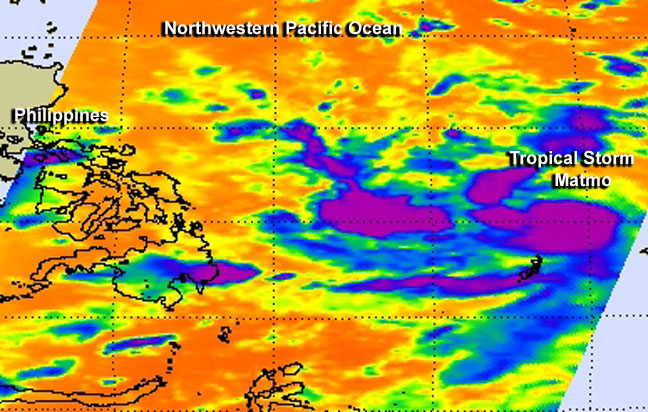NASA Sees Powerful Thunderstorms in Tropical Storm Matmo

This false-colored infrared image taken on July 17 from NASA's Aqua satellite shows that the concentration of the strongest thunderstorms (purple) around Tropical Storm Matmo's center and a band of thunderstorms west of center. Image Credit: NASA JPL, Ed Olsen
Infrared imagery from NASA's Aqua satellite showed very cold temperatures that indicated the high cloud tops in the powerful storms.
Tropical cyclones consist of hundreds of thunderstorms. When NASA's Aqua satellite flew over Tropical Storm Matmo on July 17 at 16:59 UTC (12:59 p.m. EDT) on July 17, the Atmospheric Infrared Sounder (AIRS) instrument obtained infrared data on the tropical cyclone.
AIRS showed some cloud top temperatures exceeded -63F/-52 C around the storm's center and in the southwestern quadrant of the storm indicating strong storms with the potential for heavy rainfall. The AIRS data was made into a false-colored image at NASA's Jet Propulsion Laboratory in Pasadena, California.
On July 18 at 1500 UTC (11 a.m. EDT) Tropical Storm Matmo's maximum sustained winds were near 40 knots (46 mph/74 kph).
Matmo was located approximately 222 nautical miles (255.5 miles/411.1 km) north of Koror, Palau, centered near 11.2 north latitude and 133.5 east longitude. Matmo has tracked west-northwestward at 3 knots (3.4 mph/5.5 kph).
The Joint Typhoon Warning Center forecast indicates that Matmo will reach typhoon intensity by July 20 as it continues on a northwesterly track toward landfall in northern Taiwan around July 23 as a typhoon.
Text credit: Rob Gutro
NASA's Goddard Space Flight Center
Media Contact
More Information:
http://www.nasa.gov/content/goddard/10w-northwest-pacific-ocean/All latest news from the category: Earth Sciences
Earth Sciences (also referred to as Geosciences), which deals with basic issues surrounding our planet, plays a vital role in the area of energy and raw materials supply.
Earth Sciences comprises subjects such as geology, geography, geological informatics, paleontology, mineralogy, petrography, crystallography, geophysics, geodesy, glaciology, cartography, photogrammetry, meteorology and seismology, early-warning systems, earthquake research and polar research.
Newest articles

Properties of new materials for microchips
… can now be measured well. Reseachers of Delft University of Technology demonstrated measuring performance properties of ultrathin silicon membranes. Making ever smaller and more powerful chips requires new ultrathin…

Floating solar’s potential
… to support sustainable development by addressing climate, water, and energy goals holistically. A new study published this week in Nature Energy raises the potential for floating solar photovoltaics (FPV)…

Skyrmions move at record speeds
… a step towards the computing of the future. An international research team led by scientists from the CNRS1 has discovered that the magnetic nanobubbles2 known as skyrmions can be…




















